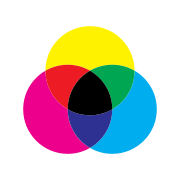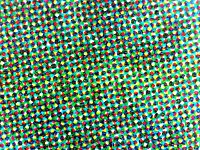
Back النموذج اللوني سيان ماجنتا أصفر أسود Arabic CMYK Azerbaijani CMYK BAR CMYK Byelorussian CMYK цветови модел Bulgarian সিএমওয়াইকে রং মডেল Bengali/Bangla CMYK Breton Model de color CMYK Catalan CMYK Czech CMYK Danish
The CMYK color model (also known as process color, or four color) is a subtractive color model, based on the CMY color model, used in color printing, and is also used to describe the printing process itself. The abbreviation CMYK refers to the four ink plates used: cyan, magenta, yellow, and key (most often black).
The CMYK model works by partially or entirely masking colors on a lighter, usually white, background. The ink reduces the light that would otherwise be reflected. Such a model is called subtractive because inks subtract some colors from white light; in the CMY model, white light minus red leaves cyan, white light minus green leaves magenta, and white light minus blue leaves yellow.
In additive color models, such as RGB, white is the additive combination of all primary colored lights, and black is the absence of light. In the CMYK model, it is the opposite: white is the natural color of the paper or other background, and black results from a full combination of colored inks. To save cost on ink, and to produce deeper black tones, unsaturated and dark colors are produced by using black ink instead of or in addition to combinations of cyan, magenta, and yellow.
The CMYK printing process was invented in the 1890s, when newspapers began to publish color comic strips.



